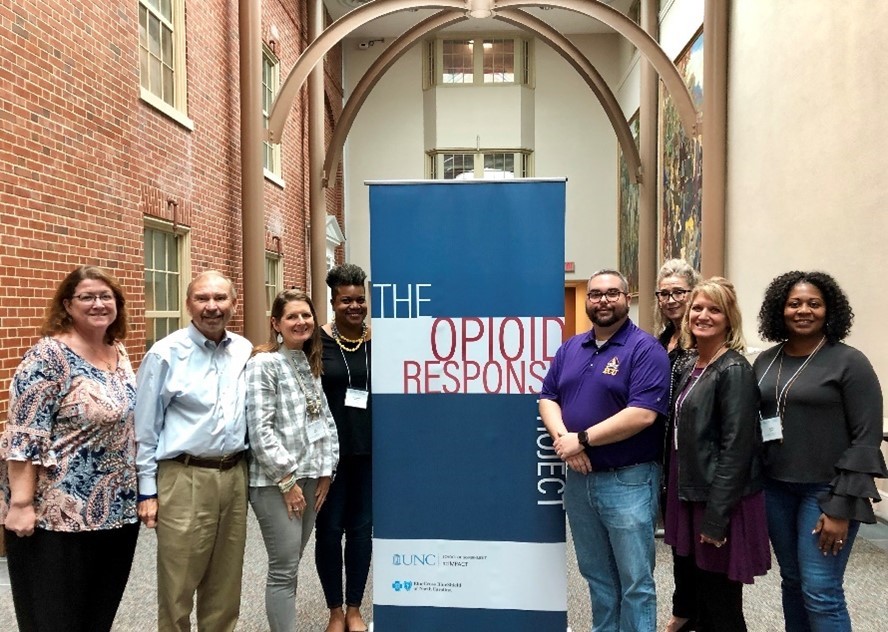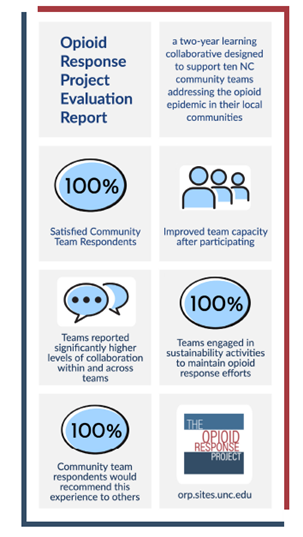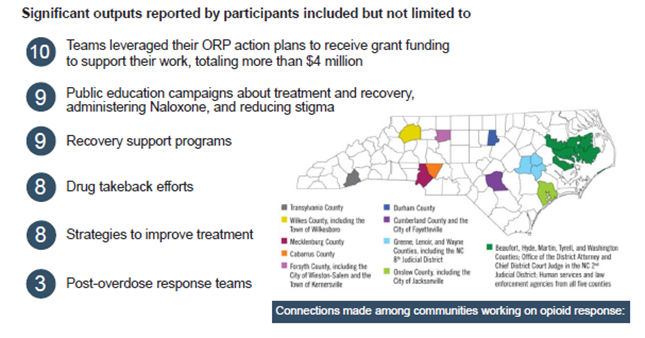Opioid Response Project Impact
The Opioid Response Project launched in 2018 and applied the Collective Impact Model to support local collaboratives in efforts to mitigate the opioid epidemic in their communities. The Opioid Response Project local teams all reported improvements in their ability to collaborate and developed action plans with strategies ranging from public information campaigns to post-overdose response teams, which they implemented.

About the Opioid Response Project
The Opioid Response Project (ORP) launched in 2018 and applied the Collective Impact Model to support local collaboratives in efforts to mitigate the opioid epidemic in their communities. The ORP was led by UNC School of Government faculty and coordinated by the ncIMPACT Initiative. The project involved ten community teams in efforts designed around four major goals:
- Plan, deliver, and continuously refine activities in support of local community teams responding to the opioid crisis;
- Strengthen the capacity of community teams for planning, implementing, monitoring, and sustaining their community programming;
- Strengthen collaboration and connections around opioid response efforts; and
- Disseminate resources and findings to a larger set of stakeholders.
The teams were located throughout the state and comprised of community leaders across sectors. The sectors ranged from health departments and social services, to emergency personnel, police departments, and the judicial system. The cohort of teams interacted throughout their time in the project at local meetings as well as the five statewide forums held over two years. At the forums, and throughout the project, teams shared information, exchanged ideas, and learned from experts.
Community Team Goals
During the project, each team developed goals based on their community’s priorities. In general, the goals focused on improving community health, safety, and recovery from the opioid epidemic. The goals were related to community capacity, public knowledge and perception, and direct impact on the opioid crisis. They aimed to increase community collaborations, capacity to address issues, and funding. They set goals of reducing stigma and increasing awareness and knowledge of opioid addiction, use, and misuse, the impacts of opioid use on the community, and the prevention and treatment options available. They also sought to increase access to and engagement with treatment, and to decrease access to opioids while also preventing new substance use disorder cases in their communities.
 Project Impact
Project Impact
At the conclusion of the project in 2020, evaluators surveyed the teams about the impact of the Opioid Response Project. All teams reported their team capacity had improved through participation in the Opioid Response Project and indicated satisfaction with the experience. The teams felt their collaboration improved significantly both within their team, but also across teams with whom they interacted through the project. Every team engaged in sustainability activities to ensure their work did not end with the project, but instead continued with the knowledge and capacity they had gained during the project. Every team also indicated they would recommend the experience to other communities that may want to implement the collective impact model. All ten teams leveraged their action plans developed during the ORP to receive grant funding to support their work, totaling more than $4 million.
Looking Ahead
The local teams continue their work in addressing the opioid epidemic, and each feels more prepared to collaborate effectively to do so. Each team approached the issue differently, reflecting the varied types of communities affected by the opioid crisis. For more information on each team’s experience see the team spotlights and videos linked here:
- 2nd Judicial District – Video
- 8th Judicial District – Video
- Cabarrus County – Video
- Cumberland County – Video
- Durham County – Video
- Forsyth County – Video
- Mecklenburg County – Video
- Onslow County – Video
- Transylvania County – Video
- Wilkes County – Video
The Opioid Response Project also included information gathering and sharing so that other communities in North Carolina can address the opioid epidemic. The ORP Resource Library includes information and resources on North Carolina opioid data; access to treatment and recovery support; children and youth engagement; education and media campaigns; harm reduction strategies; justice-involved individuals; medication initiatives; syringe exchange programs; telehealth, virtual resources and COVID-19. Additionally, faculty are writing a community guide that will be posted to the website soon. This guide will provide communities with information about how to implement the collective impact model in their communities.

